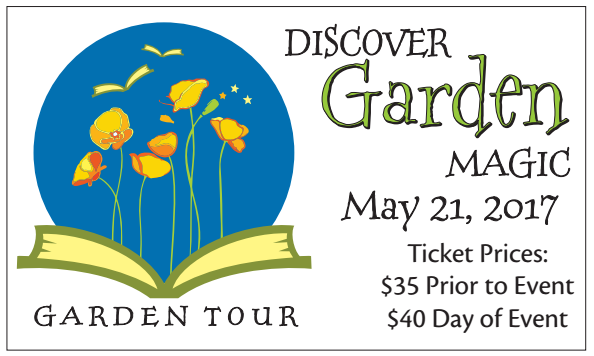West of St. Helena in Napa Valley sits a lovely garden surrounding a small house with a large porch and big picture window. I had an opportunity to speak with the owner, Glenn, about how this idyllic spot came to fruition.
Several years ago, Glenn and Anne purchased this home hoping to retire in the next few years. They saw the potential in an outdated but solidly built home in the perfect spot, along a country lane yet close to town.
They needed to renovate the house first, and then plan the garden. They launched their project by hiring a landscape and garden designer to help clarify their vision for the plot. Seven elements of good design guided their decisions. They needed to consider the function, site, hardscaping, microclimate, water management, plant selection and maintenance of their ideal home.
Function: The landscape designer asked questions to help determine which design would best support their interests and needs. Glenn and Anne were asked how they planned to use their garden. Did they plan to entertain? If so, where? Did they have any specific plants in mind?
The couple expressed a desire for an aesthetically pleasing garden that would also be water- efficient, sustainable, friendly to wildlife and care-free. In the front yard, which the public could see, they wanted an attractive landscape featuring plants with color, scent and texture. They also wanted to attract butterflies, bees and birds, and they wanted color in every season. The backyard was to be a place to contemplate, sit quietly, read a book and entertain.
Site: Since guests would park on the street, the home needed a walkway from the street to the front door. The couple parks their own vehicles in the driveway to the left of a house, so another walkway was needed from the front door to the driveway.
Hardscaping: When the project began, California was in the middle of a serious drought. To conserve rain water, a swale (a depression between slopes) and series of berms (an earthen embankment defining the swale) were added to the front garden to percolate moisture into the soil. A fountain was added for birds and butterflies and placed so that it can be seen from the front porch and window.
The backside of the house had several steps and levels. The homeowners decided to make the landscape two levels and use locally mined paving stones on the lower level to the creek edge. To protect the house from water, the paved area slants away from the house and toward the creek. Well-placed potted plants protect people from accidently moving to the edge of the creek.
Several trees were dug up. An olive tree was removed and given away. Two crepe myrtles were moved from the backyard to the front.
Microclimate: The front of the house faces south; the back faces north. With a southern exposure, the front tends to be hot in summer, making it a good site for plants that flourish with little water. The trees and boxwood hedges on both the east and west sides of the front garden create several microclimates requiring differing kinds of plants.
With its northern exposure, the backyard is cool and moist, with little variation in climate. It is ideal for water-loving plants.
Water management: Once the two levels were defined in the backyard, the grass was removed using the sheet-mulching method. In the fall, a plan for watering was devised. The design relies in two drip systems. The main pipes for the back were placed under the paving stones. Glenn chose a meter that he manually adjusts himself according to variations in rainfall and temperature.
Plant selection: As you enter the front walkway, the scent of night-blooming jasmine (Nyctanthes arbor-tristis), English lavender (Lavandula angustifolia) and mock orange (Philadelphus) greet you. At the base of the porch steps, pots of gardenia (Gardenia jasminoides), one on each side, add to the scent. Sun-loving California fuchsia (Epilodium) andmanzanita (Arctostaphylos spp) are among the plants that grow atop the berms that define the natural stone swale meandering through the garden. Both attract butterflies, hummingbirds and bees.
Below the boxwood (Buxus) are newly planted red-twig dogwoods (Cornus sericiae). In the corner below the porch is Anne's “conversation corner” shaded by the bloodgood Japanese maple (Acer palmatum). Other plants for the back garden include a fragrant flowering currant (Ribes sanguineum ‘White Icicle'), dwarf hydrangea (Hydrangea paniculata ‘Bobo') and prostrate rosemary covering the creek bank.
Maintenance: Anne and Glenn can keep up the garden themselves due to the low-maintenance design. When they need help for tasks like transplanting trees, they hire local people.
For an opportunity to be inspired and learn more, you can visit Glenn and Anne's' garden on Sunday, May 21. It is one of six Master Gardener-owned gardens featured on the U. C. Master Gardeners of Napa County's “Discover Garden Magic” tour. Purchase tickets online at
http://ucanr.edu/survey/survey.cfm?surveynumber=20204
Master Gardeners are volunteers who help the University of California reach the gardening public with home gardening information. U. C. Master Gardeners of Napa County ( http://ucanr.edu/ucmgnapa/) are available to answer gardening questions in person or by phone, Monday, Wednesday and Friday, 9 a.m. to Noon, at the U. C. Cooperative Extension office, 1710 Soscol Avenue, Suite 4, Napa, 707-253-4143, or from outside City of Napa toll-free at 877-279-3065. Or e-mail your garden questions by following the guidelines on our web site. Click on Napa, then on Have Garden Questions? Find us on Facebook under UC Master Gardeners of Napa County.
